- Joined
- Dec 27, 2014
- Messages
- 658
I am not sure where to post this, so moderators please move if there is a better place for it.
See also my new thread "Moving a Half Ton lathe."
http://www.hobby-machinist.com/threads/safely-move-a-half-ton-lathe.40368/
Moving heavy machinery is a topic that seems to come up on a regular basis, so I figured I would share my latest experience. I recently drove to Pittsburg and brought home a PM450G mill, and moved it down some unsafe stairs into the basement. The machine weighs in at 975lbs, so this took a bit of planning. I will try to cover as much detail as possible, and cover what I consider to be the most important and often overlooked points.
When I read comments from people about moving their new machine, the most common factor that I see is either failing to, or being unwilling to spend money. Getting a machine into the shop, and then getting it up on the stand will cost some money if you want to give even the smallest protection to your investment (not to mention your body). It is really easy to blow your wad on the machine itself and not have anything left over to rig with. The cost does not have to be high, but for a few bucks more a day long job that will leave you and your friends with sore bodies can be done easily in a few hours with ease.
In my mind, the two most important items for moving a machine are a chain fall and a folding engine hoist. I got both at Harbor Freight. A chain fall is cheap enough to easily justify the cost. It feels hard to justify the cost for the engine hoist because it will see so little use, but a crane of some kind is essential to any shop with machines that can't be lifted by hand. You can sell it for close to what you paid for it on Craig's List when you are done if you do not want it taking up space. I already had a chain fall that I acquired years ago, the hoist I purchase more recently - I just waited for it to go on sale.
After that, you need some rigging. 2" tow straps (Harbor Freight again) are about the best thing for putting on the machine. Never use twisted rope for hoisting. Some 3' lengths of chain with a hook on each end are a good idea as well. Mine are chains that tow truck drivers use, I harvested them off of cars over the years when I was a mechanic.
A helper is also a really good idea. Helpers will volunteer ideas about better ways to do things, share your misery, give you an extra set of eyes, and call 911 when you get pinned trying to catch your falling machine. If you have no one to help, at least keep your phone on your body in case the worst happens.
Trailering:
It seems simple, just stick the machine in the trailer and go.
It is really important that you get the trailer properly balanced even if going a short distance.
60% of the weight should be in front of the axle. Avoid putting more than 80% of the weight in front of the axle. Never put the weight behind the axle, go get a bigger trailer.
A metal machine and a metal trailer are a very bad combination. Metal is just too slippery. If you are going to move an un-palleted machine in a U-Haul, bring along a sheet of OSB or 1/4" plywood to go in between. OSB is dirt cheap, and if you leave it out in the rain for a few days, it will sweep up and go into the trash. Do not overlook this detail. You can't control other drivers, and your machine might come flying to the front of the trailer if you have to panic stop because of some other driver.
The really big mistake I see people make is in using tie downs. "Down" is the operative word in tie down. Never use straps to hold the machine centered in the trailer. The strap should be angled up at the very least 45 degrees, but you really want it angled up over 60 degrees. You want to apply downward force. You simply can not prevent a machine that weighs 500lbs or more from shifting when strapped side to side with a piece of webbing. Chains are use for side strapping loads, and are tightened with a turn buckle or come-along.
Not only are you risking having an accident, you could very well get pulled over by the cops for improperly securing a load. In my state this is actually a high misdemeanor - it is a pretty expensive rap to get out of. State Troopers will recognize improperly secured loads.
lastly, do not trust the rings they put inside moving vans and some trailers. I have read a few stories from people who had the rings rip right off moving anything from machines to pianos. Find a larger ring, or run the strap to the outside of the trailers and hook the frame.
My mill came on a pallet attached to the stand. I asked Matt to remove the stand and bolt the machine back to the pallet. We balanced the mill just past the axle, then strapped the stand to the front of the trailer. The stand only weighs about 75lbs, so it was fine to use a 1" strap and draw it tight up against the front with a piece of 2x10 scrap as a spacer.
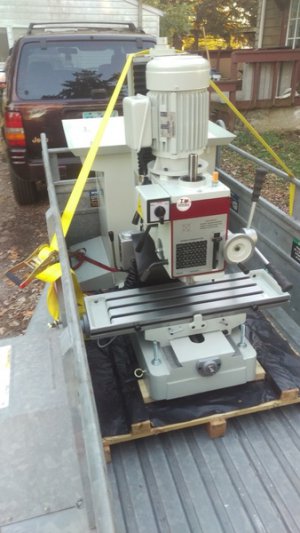
I did not notice that when Matt and I put the strap on that we crossed the rail differently until I was in Ohio. I figured it made it down I79 just fine, so it would be ok the rest of the way.
Since my mill is now an Ohio resident, it was also able to go votingon the way home
Once the machine was home, I took moving it in stages. Get the machine to the back of the trailer. Hoist the machine off the trailer. Move the machine to outside the door. Move the machine through the door. Move the machine down the stairs. Move the machine to it's final home. Thinking it through in little steps like this really helps. On the same day we moved the mill, we also moved my entire shop from a first floor bedroom into the basement. Moving the mill was about the easiest part since I had planned it all out carefully. Moving my 500lbs SC8 lathe on the other hand took a lot of grunt work and cursing because we just went at it with not much planning.
My garage is on the back of the house, and has a door with access down to the basement and up to the kitchen.
My basement stairs are pretty scary, they are definitely not up to the task.
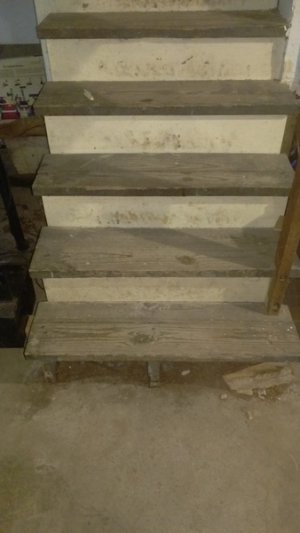
I drove two 4x4 posts under the top kick board. The top kick board is actually load bearing for the basement landing, so supporting this also supported the floor of the landing.
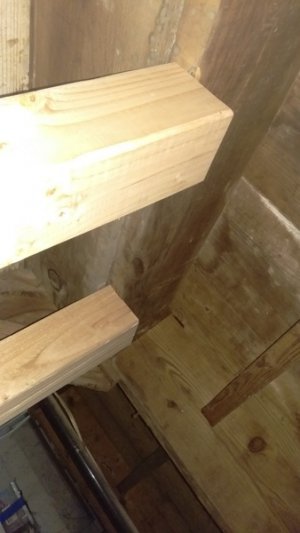
I was still not confident in the floor, so I made 2x12 ramps that would span the entire landing, and reach the basement with out contacting the steps. The pic below shows one of the ramps in place. Note that it sits on shims at one end on the garage floor, and above the top kick plate in the middle, and the basement floor at the bottom.
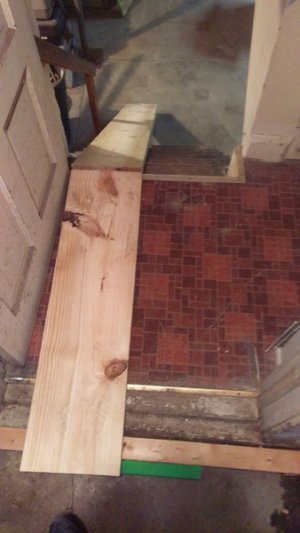
What is really critical is that the ramp bear flat on the top stair, and that the ramp is not able to slide down the stairs. I accomplished this by inletting a large strap hinge on the bottom side of the ramp. The hinge itself does not bear any weight, and I would not trust it to support any weight. It's sole purpose is to tie the ramp parts together so it can not slide down the stairs. At the top end near the door, I countersunk two 6" long lag bolts through the floor to keep the whole rig anchored at the top. I went with the hinges because it is simple, and I knew I would want to be able to block up the bottom of the ramp to assist getting machinery onto my dolly.
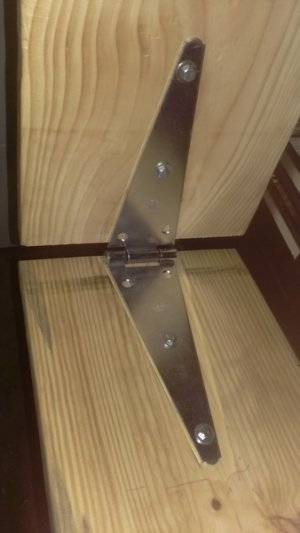
To shift the mill on the trailer and to lower it down the stairs, I sunk an anchor into the floor of the garage that was centered both for the basement door, and the garage door. I bolted a length of chain to the anchor so I could hook onto it.
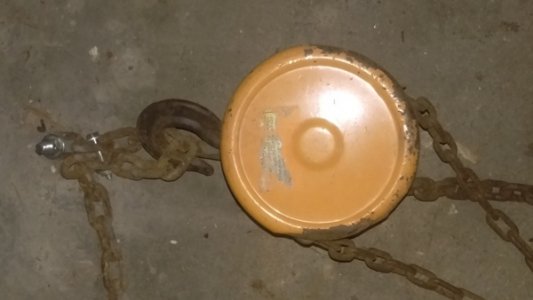
I backed the trailer into the garage, and used a come-along attached to the anchor to drag it to the back of the trailer. It was then a simple matter to pick the mill with the crane and drive the trailer out from under it.
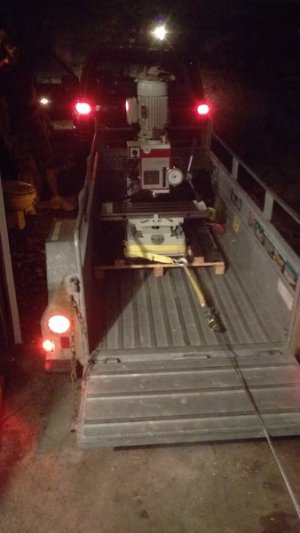
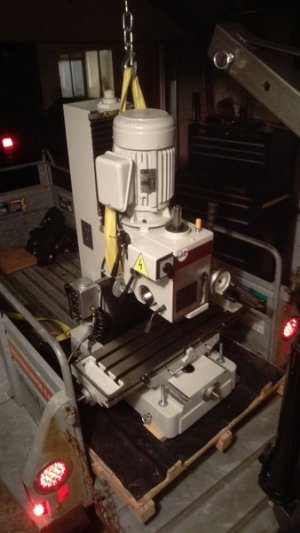
We then unbolted the mill from the pallet and bolted it onto a pair of 2x4 skids. Once the mill was on the skids, we set it on the crane legs to roll it over to the door.
I sunk another anchor in the basement floor as far from the stairs as I could get, but still able to reach the top with my rigging. We positioned the chain fall at the top for lowering, and put the come-along at the bottom to drag into the house and down the ramp.
This is where planning comes in really well. The table is actually wider than my door way. We had to shoe horn it around the door frame using a combination of pulling from below with the chain fall, a bit of muscle, and some prying with a pry bar. The mil also has to go past the front wheels of the crane as well. We took it slow and easy, lowering the crane as it went through the door so the whole thing sort of pivoted and soft landed on the ramp.
Once the mill was through the door, we dismantled the crane and passed it through the kitchen and into the basement. After that I attached a 1" safety strap to the upper part of the mill to prevent it from making any wild movement as it went over the edge. It is important here to rig the mill low rather than high. If you rig high, the bottom can slide out from under the mill. When rigged low, the danger is it tipping forward, and that is controlled by a safety strap and going slow. It is important to remove the strap before it goes too far over the edge, or it might tip the mill backwards.
Here is a series of pics of the mill going over the edge and down the stairs. Notice there is less than an inch to each side, and we had to bend the banister out of the way at the bottom.
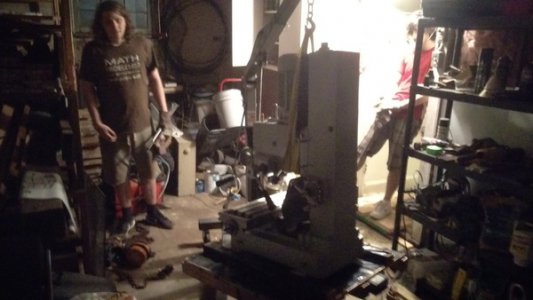
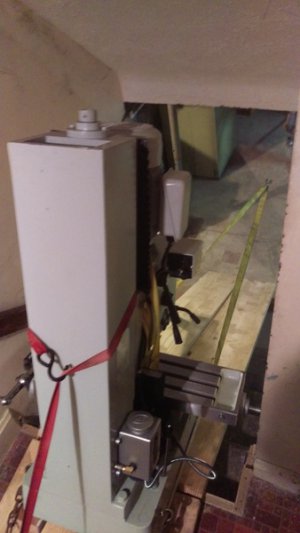
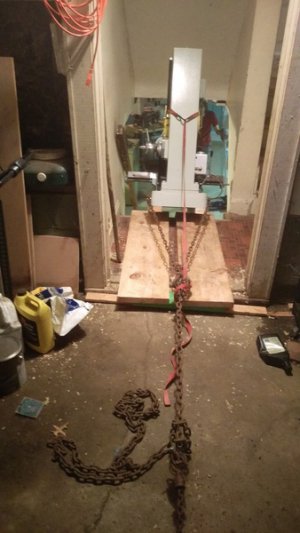
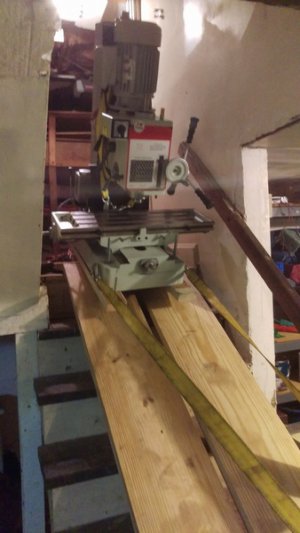
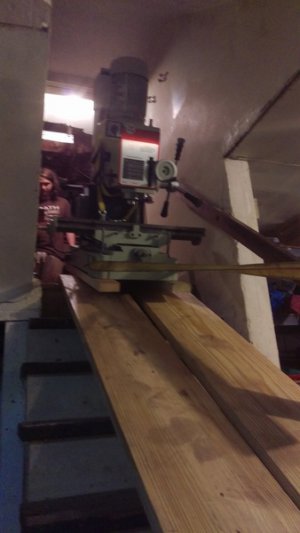
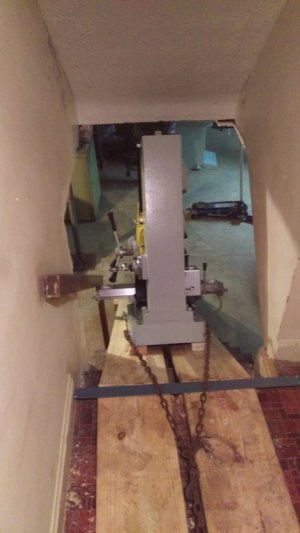
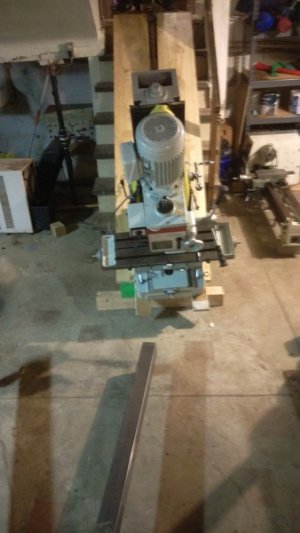
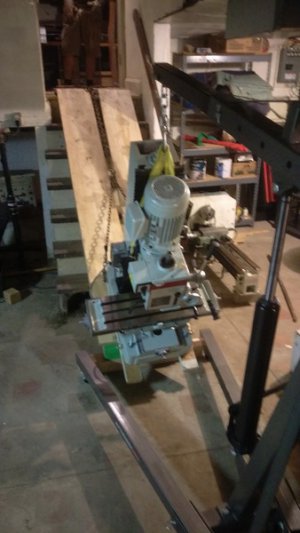
There are a lot of good details in the pics, so they are worth looking over carefully. Note that it was under tension from top and bottom until it went entirely over the edge to prevent it from making a wild tip. I removed the safety strap when it was balanced on the edge. The metal strip is a piece of shelving unit that got repurposed and keeps the chain links from catching. I pried it up and out when the big hook reached it. I also had to be constantly be on the lookout for the hook wedging between the ramps. The bottom of the ramp was blocked up on two 4x4 so the mill could reach the bottom of the ramp before the skids hit the floor. We lifted the mill off the ramp rather than let is go all the way to the floor.
An observant person might also notice that at full extension, my crane is only rater ate 500lbs. The crane had absolutely no trouble lifting the 900+lbs mill. The frame is much stronger than it is rated, and the hydraulic ram will simply fail to lift before the crane collapses. You would not want to abuse this crane this way on a daily basis, but it will be just fine done occasionally.
We did this as a three man job, though two would do it just fine. I spotted and called orders, my son Akiva ran the chain fall, and his buddy Kenneth ran the come-along. All told from when I started backing the trailer, to mill on the stand took about 1 1/2 hours. We moved slow and steady, but it went smoothly with no issues.
here is a pick of it in it's new home. Note the motor actually goes up into the rafters.
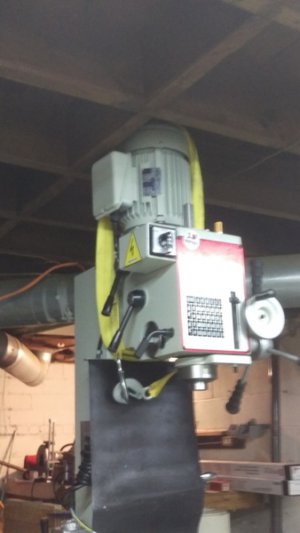
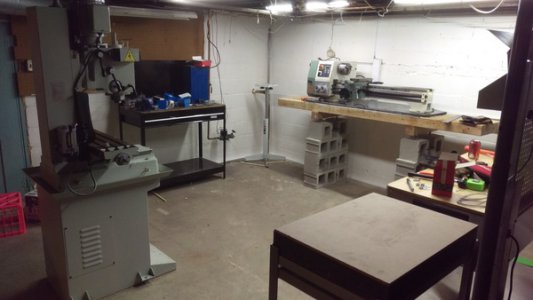
I hope someone will find this helpful.
Feel free to add comments for alternate methods, or corrections. I will endeavor to fix mistakes or answer questions.
-Josh
See also my new thread "Moving a Half Ton lathe."
http://www.hobby-machinist.com/threads/safely-move-a-half-ton-lathe.40368/
Moving heavy machinery is a topic that seems to come up on a regular basis, so I figured I would share my latest experience. I recently drove to Pittsburg and brought home a PM450G mill, and moved it down some unsafe stairs into the basement. The machine weighs in at 975lbs, so this took a bit of planning. I will try to cover as much detail as possible, and cover what I consider to be the most important and often overlooked points.
When I read comments from people about moving their new machine, the most common factor that I see is either failing to, or being unwilling to spend money. Getting a machine into the shop, and then getting it up on the stand will cost some money if you want to give even the smallest protection to your investment (not to mention your body). It is really easy to blow your wad on the machine itself and not have anything left over to rig with. The cost does not have to be high, but for a few bucks more a day long job that will leave you and your friends with sore bodies can be done easily in a few hours with ease.
In my mind, the two most important items for moving a machine are a chain fall and a folding engine hoist. I got both at Harbor Freight. A chain fall is cheap enough to easily justify the cost. It feels hard to justify the cost for the engine hoist because it will see so little use, but a crane of some kind is essential to any shop with machines that can't be lifted by hand. You can sell it for close to what you paid for it on Craig's List when you are done if you do not want it taking up space. I already had a chain fall that I acquired years ago, the hoist I purchase more recently - I just waited for it to go on sale.
After that, you need some rigging. 2" tow straps (Harbor Freight again) are about the best thing for putting on the machine. Never use twisted rope for hoisting. Some 3' lengths of chain with a hook on each end are a good idea as well. Mine are chains that tow truck drivers use, I harvested them off of cars over the years when I was a mechanic.
A helper is also a really good idea. Helpers will volunteer ideas about better ways to do things, share your misery, give you an extra set of eyes, and call 911 when you get pinned trying to catch your falling machine. If you have no one to help, at least keep your phone on your body in case the worst happens.
Trailering:
It seems simple, just stick the machine in the trailer and go.
It is really important that you get the trailer properly balanced even if going a short distance.
60% of the weight should be in front of the axle. Avoid putting more than 80% of the weight in front of the axle. Never put the weight behind the axle, go get a bigger trailer.
A metal machine and a metal trailer are a very bad combination. Metal is just too slippery. If you are going to move an un-palleted machine in a U-Haul, bring along a sheet of OSB or 1/4" plywood to go in between. OSB is dirt cheap, and if you leave it out in the rain for a few days, it will sweep up and go into the trash. Do not overlook this detail. You can't control other drivers, and your machine might come flying to the front of the trailer if you have to panic stop because of some other driver.
The really big mistake I see people make is in using tie downs. "Down" is the operative word in tie down. Never use straps to hold the machine centered in the trailer. The strap should be angled up at the very least 45 degrees, but you really want it angled up over 60 degrees. You want to apply downward force. You simply can not prevent a machine that weighs 500lbs or more from shifting when strapped side to side with a piece of webbing. Chains are use for side strapping loads, and are tightened with a turn buckle or come-along.
Not only are you risking having an accident, you could very well get pulled over by the cops for improperly securing a load. In my state this is actually a high misdemeanor - it is a pretty expensive rap to get out of. State Troopers will recognize improperly secured loads.
lastly, do not trust the rings they put inside moving vans and some trailers. I have read a few stories from people who had the rings rip right off moving anything from machines to pianos. Find a larger ring, or run the strap to the outside of the trailers and hook the frame.
My mill came on a pallet attached to the stand. I asked Matt to remove the stand and bolt the machine back to the pallet. We balanced the mill just past the axle, then strapped the stand to the front of the trailer. The stand only weighs about 75lbs, so it was fine to use a 1" strap and draw it tight up against the front with a piece of 2x10 scrap as a spacer.

I did not notice that when Matt and I put the strap on that we crossed the rail differently until I was in Ohio. I figured it made it down I79 just fine, so it would be ok the rest of the way.
Since my mill is now an Ohio resident, it was also able to go votingon the way home
Once the machine was home, I took moving it in stages. Get the machine to the back of the trailer. Hoist the machine off the trailer. Move the machine to outside the door. Move the machine through the door. Move the machine down the stairs. Move the machine to it's final home. Thinking it through in little steps like this really helps. On the same day we moved the mill, we also moved my entire shop from a first floor bedroom into the basement. Moving the mill was about the easiest part since I had planned it all out carefully. Moving my 500lbs SC8 lathe on the other hand took a lot of grunt work and cursing because we just went at it with not much planning.
My garage is on the back of the house, and has a door with access down to the basement and up to the kitchen.
My basement stairs are pretty scary, they are definitely not up to the task.

I drove two 4x4 posts under the top kick board. The top kick board is actually load bearing for the basement landing, so supporting this also supported the floor of the landing.

I was still not confident in the floor, so I made 2x12 ramps that would span the entire landing, and reach the basement with out contacting the steps. The pic below shows one of the ramps in place. Note that it sits on shims at one end on the garage floor, and above the top kick plate in the middle, and the basement floor at the bottom.

What is really critical is that the ramp bear flat on the top stair, and that the ramp is not able to slide down the stairs. I accomplished this by inletting a large strap hinge on the bottom side of the ramp. The hinge itself does not bear any weight, and I would not trust it to support any weight. It's sole purpose is to tie the ramp parts together so it can not slide down the stairs. At the top end near the door, I countersunk two 6" long lag bolts through the floor to keep the whole rig anchored at the top. I went with the hinges because it is simple, and I knew I would want to be able to block up the bottom of the ramp to assist getting machinery onto my dolly.

To shift the mill on the trailer and to lower it down the stairs, I sunk an anchor into the floor of the garage that was centered both for the basement door, and the garage door. I bolted a length of chain to the anchor so I could hook onto it.

I backed the trailer into the garage, and used a come-along attached to the anchor to drag it to the back of the trailer. It was then a simple matter to pick the mill with the crane and drive the trailer out from under it.


We then unbolted the mill from the pallet and bolted it onto a pair of 2x4 skids. Once the mill was on the skids, we set it on the crane legs to roll it over to the door.
I sunk another anchor in the basement floor as far from the stairs as I could get, but still able to reach the top with my rigging. We positioned the chain fall at the top for lowering, and put the come-along at the bottom to drag into the house and down the ramp.
This is where planning comes in really well. The table is actually wider than my door way. We had to shoe horn it around the door frame using a combination of pulling from below with the chain fall, a bit of muscle, and some prying with a pry bar. The mil also has to go past the front wheels of the crane as well. We took it slow and easy, lowering the crane as it went through the door so the whole thing sort of pivoted and soft landed on the ramp.
Once the mill was through the door, we dismantled the crane and passed it through the kitchen and into the basement. After that I attached a 1" safety strap to the upper part of the mill to prevent it from making any wild movement as it went over the edge. It is important here to rig the mill low rather than high. If you rig high, the bottom can slide out from under the mill. When rigged low, the danger is it tipping forward, and that is controlled by a safety strap and going slow. It is important to remove the strap before it goes too far over the edge, or it might tip the mill backwards.
Here is a series of pics of the mill going over the edge and down the stairs. Notice there is less than an inch to each side, and we had to bend the banister out of the way at the bottom.








There are a lot of good details in the pics, so they are worth looking over carefully. Note that it was under tension from top and bottom until it went entirely over the edge to prevent it from making a wild tip. I removed the safety strap when it was balanced on the edge. The metal strip is a piece of shelving unit that got repurposed and keeps the chain links from catching. I pried it up and out when the big hook reached it. I also had to be constantly be on the lookout for the hook wedging between the ramps. The bottom of the ramp was blocked up on two 4x4 so the mill could reach the bottom of the ramp before the skids hit the floor. We lifted the mill off the ramp rather than let is go all the way to the floor.
An observant person might also notice that at full extension, my crane is only rater ate 500lbs. The crane had absolutely no trouble lifting the 900+lbs mill. The frame is much stronger than it is rated, and the hydraulic ram will simply fail to lift before the crane collapses. You would not want to abuse this crane this way on a daily basis, but it will be just fine done occasionally.
We did this as a three man job, though two would do it just fine. I spotted and called orders, my son Akiva ran the chain fall, and his buddy Kenneth ran the come-along. All told from when I started backing the trailer, to mill on the stand took about 1 1/2 hours. We moved slow and steady, but it went smoothly with no issues.
here is a pick of it in it's new home. Note the motor actually goes up into the rafters.


I hope someone will find this helpful.
Feel free to add comments for alternate methods, or corrections. I will endeavor to fix mistakes or answer questions.
-Josh
Last edited:

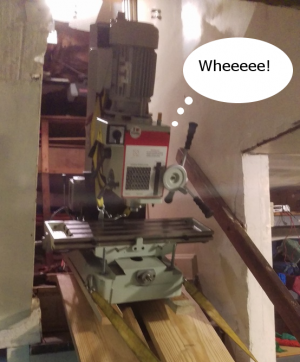
 .
.